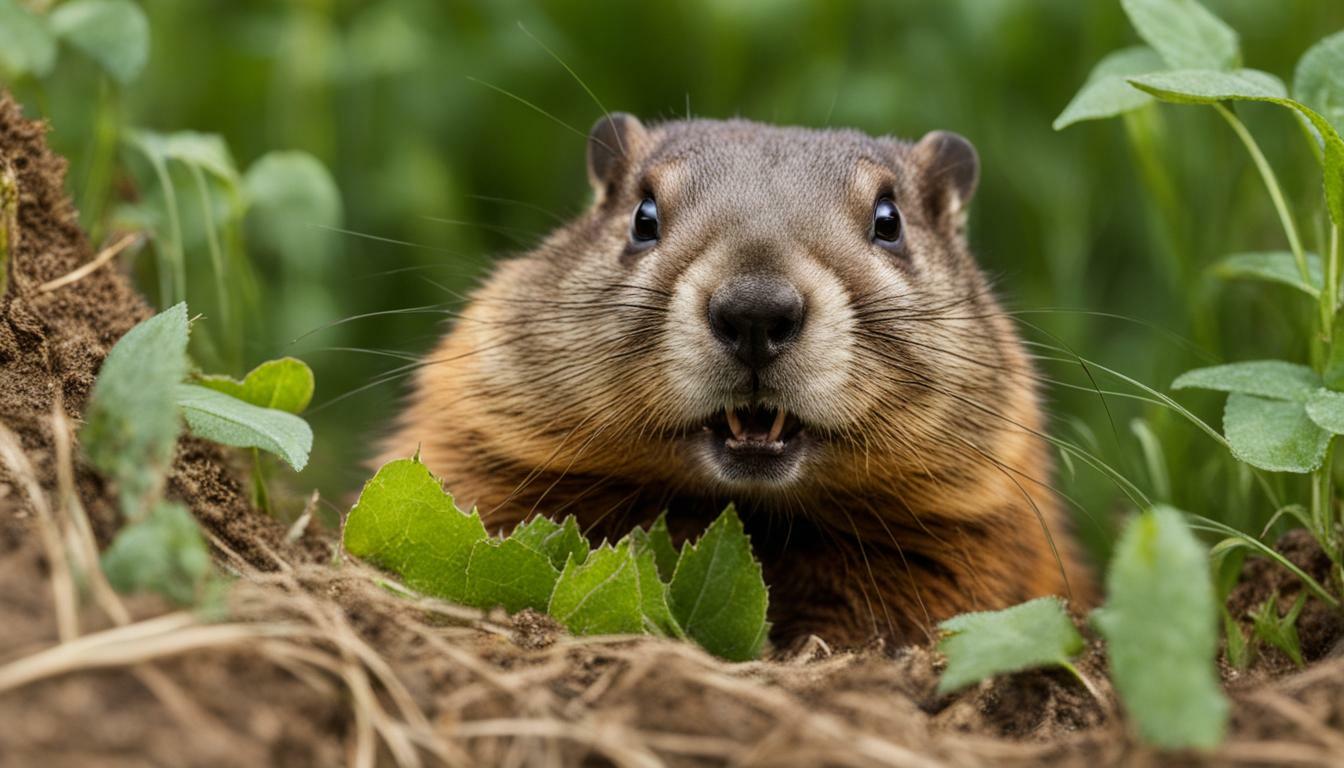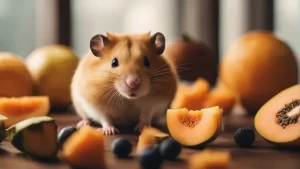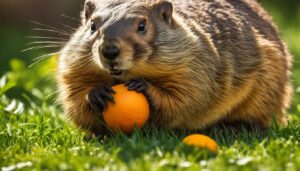Are groundhogs capable of consuming ticks as part of their diet? Let’s find out more about the feeding habits of these herbivores.
Key Takeaways:
- Groundhogs are herbivores and primarily eat plant-based foods.
- While groundhogs do not typically eat ticks, there are other animals that are known to consume ticks.
- Animals such as guinea fowl, chickens, turkeys, opossums, chipmunks, squirrels, frogs, toads, and certain species of birds and spiders play a role in tick control.
- Raccoons and certain species of wasps also consume ticks.
- It’s important to note that while some animals may eat ticks, their impact on tick populations may vary.
Groundhog Diet and Feeding Habits
Groundhogs, also known as woodchucks, are herbivores that rely on a diet consisting mostly of plants and vegetation. They have a preference for consuming grasses, clovers, and other leafy greens. As burrowing animals, groundhogs are opportunistic feeders and will graze on a variety of plants found in their habitat.
While groundhogs have a predominantly herbivorous diet, they may occasionally sample fruits and vegetables if available. However, their primary focus is on consuming and processing plant matter. Their strong, chisel-like teeth and powerful jaws enable them to gnaw on tough vegetation.
These rodents are known for their voracious appetites during the spring and summer months when their activity levels increase. During this time, groundhogs actively seek out fresh foliage and flowers to sustain their nutritional needs.
The Role of Groundhogs in Ecological Balance
Groundhogs play an important role in ecosystems as their feeding habits have a direct impact on the vegetation around them. By consuming and controlling plant growth, they can help maintain a healthy balance in their environment.
| Food | Description |
|---|---|
| Grasses | A staple in the groundhog diet, providing essential nutrients |
| Clovers | Rich in protein and a common food source for groundhogs |
| Leafy Greens | Groundhogs enjoy a variety of leafy greens for nutrition |
- Groundhogs are herbivores that rely on a plant-based diet.
- They primarily consume grasses, clovers, and leafy greens.
- Occasionally, they may sample fruits and vegetables.
- Groundhogs play a role in maintaining ecological balance by regulating plant growth.
While groundhogs don’t eat ticks, they are important contributors to their ecosystems. By understanding their diet and feeding habits, we can appreciate the role they play in maintaining a healthy environment.
Tick Predation by Animals
While ticks are preyed upon by several animals, groundhogs are not typically known to be among those consuming ticks. Groundhogs are herbivores and primarily eat a plant-based diet, consisting of grasses, leaves, and other vegetation. Their feeding habits do not include consuming ticks as part of their natural diet.
However, there are many other animals that do eat ticks and play a role in controlling tick populations. Animals such as guinea fowl, chickens, turkeys, and opossums are known to consume ticks. These animals have natural instincts and behaviors that make them effective tick predators.
Additionally, other creatures like chipmunks, squirrels, frogs, toads, and certain species of birds and spiders also feed on ticks. Some birds, such as oxpeckers and ducks, are known to actively seek out ticks on larger animals. Spiders like wolf spiders and brown recluse spiders are also natural predators of ticks.
| Animals That Eat Ticks | Tick Control |
|---|---|
| Guinea fowl | Effective |
| Chickens | Effective |
| Turkeys | Effective |
| Opossums | Effective |
| Chipmunks | Partial |
| Squirrels | Partial |
| Frogs and toads | Partial |
| Certain species of birds and spiders | Partial |
It’s important to note that while some animals may eat ticks, their effectiveness in controlling tick populations may vary. The impact of tick predation by these animals can depend on factors such as the population density of ticks, the size of the tick-consuming animal population, and their access to tick-infested areas.
A diverse ecosystem with multiple tick predators can contribute to regulating tick populations. Understanding the role of different animals in tick control is essential for implementing effective tick prevention and management strategies.
Animals That Eat Ticks
Many animals, including guinea fowl, chickens, turkeys, and opossums, actively feed on ticks as part of their natural diet. These animals serve as important tick predators, helping to control tick populations in their respective habitats. By consuming ticks, they contribute to the overall ecosystem balance and help reduce the risk of tick-borne diseases.
In addition to the aforementioned animals, other creatures such as chipmunks, squirrels, frogs, toads, and certain species of birds and spiders also play a role in tick control. For instance, certain species of birds, like oxpeckers and ducks, feed on ticks and help keep their numbers in check. Likewise, certain spider species, like wolf spiders and brown recluse spiders, are known to prey on ticks.
Groundhogs and Ticks
Groundhogs, however, are not included in the list of animals that actively consume ticks. These herbivorous creatures primarily feed on plants and vegetation and do not show a particular inclination towards ticks. While groundhogs contribute to the ecosystem in various ways, controlling tick populations is not one of their known roles.
| Animals That Eat Ticks | Tick Consumption |
|---|---|
| Guinea Fowl | Actively feed on ticks |
| Chickens | Actively feed on ticks |
| Turkeys | Actively feed on ticks |
| Opossums | Actively feed on ticks |
| Chipmunks | Contribute to tick control |
| Squirrels | Contribute to tick control |
| Frogs and Toads | Play a role in tick control |
| Birds and Spiders | Contribute to tick control |
While groundhogs are not known to eat ticks, it’s important to recognize the diverse array of animals that actively consume ticks. Their collective efforts contribute to maintaining a healthy balance in the ecosystem and help reduce the prevalence of ticks and tick-borne diseases.
Additional Tick Predators
In addition to the animals mentioned earlier, chipmunks, squirrels, frogs, toads, and certain birds and spiders are also known to be effective tick predators. These small creatures play a crucial role in controlling tick populations naturally within their habitats.
Chipmunks and squirrels are agile and quick, making them adept at catching and consuming ticks. They forage for ticks in leaf litter and dense vegetation, where ticks often reside. Frogs and toads, on the other hand, are known to feast on small insects and arachnids, including ticks. Their diet contributes to keeping tick populations in check.
Various species of birds have also been observed to consume ticks. Oxpeckers, found in Africa, have a symbiotic relationship with larger mammals, feeding on ticks that infest their hosts. Ducks, too, have been documented to eat ticks, particularly when they are near water sources, where ticks are commonly found.
| Tick Predators | Type |
|---|---|
| Chipmunks | Mammal |
| Squirrels | Mammal |
| Frogs and toads | Amphibians |
| Oxpeckers | Birds |
| Ducks | Birds |
| Spiders | Arachnids |
Some spiders, such as wolf spiders and brown recluse spiders, are also known to consume ticks. These arachnids actively hunt for ticks, playing a role in keeping their populations in check.
While groundhogs are not known to eat ticks, the diverse range of animals mentioned above provide a natural line of defense against tick populations. Their feeding habits contribute to the overall balance of ecosystems and help reduce the presence of ticks that can pose a risk to humans and animals.
The Role of Other Animals in Tick Control
While groundhogs may not directly consume ticks, their presence in ecosystems contributes to a healthy balance of tick predators, helping to control tick populations. Groundhogs are herbivores and primarily eat a plant-based diet, which does not include ticks. However, there are numerous other animals that play a crucial role in keeping tick populations in check.
One group of animals known for their tick-consuming habits is poultry. Guinea fowl, chickens, and turkeys are natural tick predators, and their foraging behavior can significantly reduce tick populations in areas where they roam. Opossums, small mammals known for their scavenging habits, also eat ticks and can help control their numbers in certain habitats.
Additionally, various woodland creatures contribute to tick control. Chipmunks and squirrels consume ticks as part of their diet, while frogs and toads are known to feed on these pests as well. Certain species of birds, such as oxpeckers and ducks, actively search for ticks on the bodies of large mammals, providing an essential cleaning service.
| Animals That Eat Ticks |
|---|
| Guinea fowl |
| Chickens |
| Turkeys |
| Opossums |
| Chipmunks |
| Squirrels |
| Frogs |
| Toads |
| Oxpeckers |
| Ducks |
It’s important to note that while these animals contribute to tick control, their effectiveness in reducing tick populations may vary depending on the specific ecosystem. Additionally, there are other tick predators not listed here, such as certain species of spiders like wolf spiders and brown recluse spiders, as well as raccoons and certain wasps.
In summary, although groundhogs do not eat ticks directly, their presence in ecosystems is still valuable for maintaining a healthy balance of tick predators. The combination of various tick-consuming animals, including guinea fowl, chickens, turkeys, opossums, chipmunks, squirrels, frogs, toads, birds like oxpeckers and ducks, spiders, raccoons, and wasps, contributes to controlling tick populations and promoting overall tick control.
Tick Control Effectiveness
While animals like groundhogs can contribute to tick control, it’s important to note that their effectiveness in managing tick populations may be limited. Groundhogs are herbivores and primarily consume a plant-based diet, which does not include ticks. However, there are several other animals that play a significant role in tick control.
Guinea fowl, chickens, turkeys, opossums, chipmunks, squirrels, frogs, toads, and certain species of birds like oxpeckers and ducks are known to eat ticks. Some spiders, such as wolf spiders and brown recluse spiders, also prey on ticks. Raccoons and certain species of wasps, known as tick wasps, are additional tick consumers.
A diverse ecosystem with multiple tick predators is crucial for effective tick control. Each of these animals contributes in its own way to keep tick populations in check. However, it’s important to note that while some animals may consume ticks, their impact on tick populations may vary and might not completely eliminate the problem.
| Animals that Eat Ticks | |
|---|---|
| Guinea fowl | Chickens |
| Turkeys | Opossums |
| Chipmunks | Squirrels |
| Frogs | Toads |
| Oxpeckers | Ducks |
| Wolf spiders | Brown recluse spiders |
| Raccoons | Tick wasps |
Raccoons and Wasps: Tick Consumers
In addition to the animals discussed earlier, raccoons and specific species of wasps are also known to consume ticks. While groundhogs do not typically eat ticks, these creatures play an important role in tick control within their ecosystems.
Raccoons are omnivorous animals that have a diverse diet, which includes ticks. They are known for their opportunistic feeding habits and will consume a variety of foods found in their habitat. This includes insects such as ticks, which they may encounter while foraging or grooming. Raccoons contribute to tick control by reducing tick populations naturally.
Specific species of wasps, such as the velvet ants, are also effective tick predators. These wasps have specialized adaptations that allow them to feed on ticks. Their hairy bodies enable them to carry ticks away from their hosts and consume them. By preying on ticks, these wasps contribute to the overall reduction of tick populations.
Table: Animals that Consume Ticks
| Animal | Tick Consumption |
|---|---|
| Guinea Fowl | High |
| Chickens | High |
| Turkeys | High |
| Opossums | High |
| Chipmunks | Moderate |
| Squirrels | Moderate |
| Frogs | Moderate |
| Toads | Moderate |
| Oxpeckers | Moderate |
| Ducks | Moderate |
| Wolf Spiders | Moderate |
| Brown Recluse Spiders | Moderate |
| Raccoons | Moderate |
| Specific Species of Wasps | Moderate |
While groundhogs may not contribute directly to tick control, a diverse ecosystem with multiple tick predators can help regulate tick populations. Understanding the role different animals play in tick predation is essential for effective tick management and prevention measures.
Understanding Tick Predation
While many animals play a vital role in controlling tick populations, groundhogs are not among those that feed on ticks. Groundhogs, also known as woodchucks, are herbivores with a diet consisting mainly of plant-based foods. Their feeding habits do not include consuming ticks, which are small parasitic insects that can transmit diseases.
However, there are numerous other animals that have been observed to feed on ticks in various ecosystems. These natural predators of ticks include guinea fowl, chickens, turkeys, opossums, chipmunks, squirrels, frogs, toads, and certain species of birds like oxpeckers and ducks. Even some spiders, such as wolf spiders and brown recluse spiders, are known to prey on ticks.
Aside from these animals, raccoons and certain species of wasps also consume ticks. The diverse range of tick predators in nature helps to regulate tick populations, as ticks serve as a food source for these animals. However, it’s important to note that while these animals may eat ticks, their effectiveness in controlling tick populations can vary.
Tick Predation by Various Animals:
| Animal | Tick Predation |
|---|---|
| Guinea Fowl | Yes |
| Chickens | Yes |
| Turkeys | Yes |
| Opossums | Yes |
| Chipmunks | Yes |
| Squirrels | Yes |
| Frogs | Yes |
| Toads | Yes |
| Oxpeckers | Yes |
| Ducks | Yes |
| Spiders (Wolf spiders, Brown recluse spiders) | Yes |
| Raccoons | Yes |
| Wasps (Certain species) | Yes |
| Groundhogs (Woodchucks) | No |
In conclusion, groundhogs are not known to eat ticks, as they are herbivores that primarily consume plant-based foods. While many animals contribute to the control of tick populations by feeding on ticks, groundhogs are not among those natural predators.
How Ticks Are Controlled
Effective tick control involves a combination of natural tick predators and human interventions to keep tick populations at bay. While groundhogs are not known to eat ticks, there are several other animals that play a crucial role in tick control. Let’s take a closer look at the different methods used to control ticks.
One of the most effective natural tick control methods is through the presence of tick predators in the ecosystem. Animals such as guinea fowl, chickens, turkeys, opossums, chipmunks, squirrels, frogs, toads, and certain species of birds and spiders feed on ticks, helping to regulate their populations. Raccoons and some types of wasps are also known to consume ticks.
Human interventions also play a vital role in tick control. This includes implementing measures to prevent ticks from infesting living spaces and pets, such as keeping lawns well-maintained, clearing brush and leaf litter, and using tick repellents on pets.
The Role of Integrated Pest Management (IPM)
Integrated Pest Management (IPM) is another approach that combines various methods to control ticks effectively. This holistic approach uses a combination of natural, cultural, and chemical control methods to manage tick populations and reduce the risk of tick-borne diseases.
| Methods of Tick Control | Advantages | Limitations |
|---|---|---|
| Natural tick predators (animals and spiders) | Eco-friendly, sustainable, and reduces reliance on chemical intervention | Predators may not entirely eliminate tick populations and may vary in effectiveness |
| Human interventions (tick repellents, lawn maintenance, pet protection) | Provides immediate protection and reduces tick exposure | May require ongoing maintenance and vigilance |
| Integrated Pest Management (IPM) | A comprehensive approach that combines different control methods | Requires expertise and coordination to implement effectively |
By utilizing a combination of natural tick predators, human interventions, and integrated pest management strategies, it is possible to minimize the presence of ticks and reduce the risks associated with tick-borne diseases. It is important to adopt a multifaceted approach and remain vigilant in tick control efforts to ensure the health and well-being of both humans and pets.
The Importance of Tick Prevention
Taking preventive measures against ticks is crucial for ensuring the well-being of both humans and pets in areas where ticks are prevalent. While groundhogs, being herbivores, do not eat ticks, there are numerous other animals that play a vital role in controlling tick populations.
One effective way to prevent tick bites is by using topical or oral tick control products for pets. These products help repel ticks and reduce the risk of tick-borne diseases. Regularly checking your pets for ticks after outdoor activities can also help remove any attached ticks before they have a chance to transmit any diseases. Additionally, keeping your yard well-maintained by removing tall grasses and reducing tick-friendly habitats can help reduce tick populations around your home.
For humans, wearing long-sleeved shirts, long pants, and closed-toe shoes when spending time in tick-infested areas can provide a physical barrier against ticks. Applying insect repellents containing DEET or picaridin to exposed skin and treating clothing with repellents containing permethrin can provide further protection. After outdoor activities, conducting a thorough tick check and promptly removing any attached ticks is essential.
| Animals That Eat Ticks |
|---|
| Guinea fowl |
| Chickens |
| Turkeys |
| Opossums |
| Chipmunks |
| Squirrels |
| Frogs |
| Toads |
| Oxpeckers (birds) |
| Ducks |
| Spider species: Wolf spiders, Brown recluse spiders |
| Raccoons |
| Wasps |
While these animals are known to consume ticks, it’s important to note that their effectiveness in controlling tick populations may vary. Tick prevention should not solely rely on natural predators, but also include human interventions such as proper yard maintenance, personal protective measures, and the use of tick control products for pets.
Conclusion
In conclusion, groundhogs are herbivores and do not typically eat ticks. Their diet primarily consists of plant-based foods, and they do not play a significant role in tick control. However, it’s important to note that there are many other animals that do consume ticks and help regulate tick populations.
Animals such as guinea fowl, chickens, turkeys, opossums, chipmunks, squirrels, frogs, toads, and certain species of birds and spiders are known to eat ticks. Raccoons and certain species of wasps also consume ticks. These animals contribute to the natural tick control ecosystem and assist in keeping tick populations in check.
While these animals do play a role in tick control, it’s essential to understand that their effectiveness may vary. Tick populations can be challenging to manage, and a combination of natural tick predators and human interventions is often necessary. Taking proactive measures such as wearing tick-repellent clothing, performing regular tick checks, and implementing tick prevention strategies for pets can help minimize the risk of tick-borne diseases.
Understanding Tick Predation
Understanding the dynamics of tick predation and the role of different animals in controlling tick populations is crucial for effective tick management. While groundhogs are not known to eat ticks, a diverse ecosystem with multiple tick predators can help maintain a balanced tick population and reduce the risk of tick-borne illnesses.
By working together with nature and implementing preventive measures, we can create an environment where tick populations are managed effectively, ensuring the health and well-being of humans and animals alike.
FAQ
Do groundhogs eat ticks?
No, groundhogs are herbivores and primarily eat a plant-based diet. They are not known to consume ticks.
What animals eat ticks?
Many animals eat ticks, including guinea fowl, chickens, turkeys, opossums, chipmunks, squirrels, frogs, toads, and birds like oxpeckers and ducks. Some spiders like wolf spiders and brown recluse spiders also eat ticks. Raccoons and certain wasps are also tick consumers.
Are groundhogs effective in controlling tick populations?
Groundhogs are not known to eat ticks, so they may not be effective in controlling tick populations. However, other animals play a role in tick control, creating a balanced ecosystem with multiple tick predators.
How do animals contribute to tick control?
Animals that eat ticks help regulate tick populations naturally. They reduce the number of ticks in their habitats, which can help lower the risk of tick-borne diseases in humans and animals.
Can raccoons and wasps consume ticks?
Yes, raccoons and certain species of wasps are known to eat ticks. They are additional tick predators in the ecosystem.
Do groundhogs have any role in tick control?
While groundhogs are not known to eat ticks, they are part of a diverse ecosystem where other animals contribute to tick control. Their role in tick control may be indirect.
How effective is tick control by animals?
Tick control by animals can help reduce tick populations, but its effectiveness varies. Multiple factors, including the diversity of tick predators and other tick control measures, contribute to overall effectiveness.
Why is understanding tick predation important?
Understanding tick predation helps us appreciate the role of different animals in keeping tick populations in check. It highlights the complex nature of tick control and the need for a comprehensive approach.
How are ticks controlled?
Tick control involves a combination of natural tick predators, such as animals mentioned earlier, and human interventions. These interventions can include regular tick checks, tick repellents, and habitat modifications to reduce tick populations.
Why is tick prevention important?
Tick prevention is crucial to reduce the risk of tick-borne diseases in humans and animals. It involves taking proactive measures to avoid tick bites, such as wearing protective clothing, using insect repellents, and keeping outdoor areas tidy.




